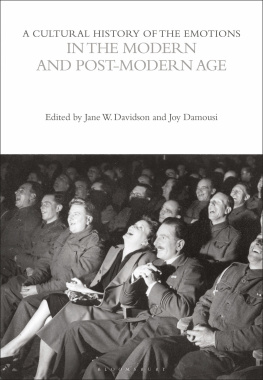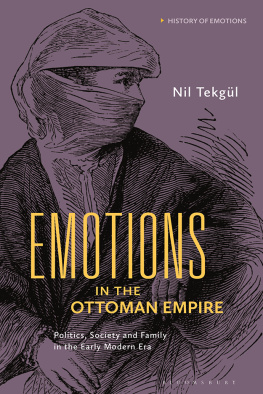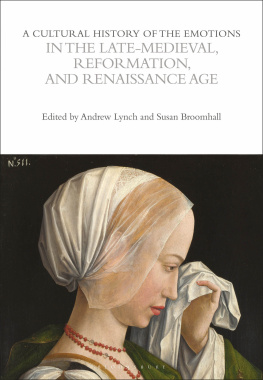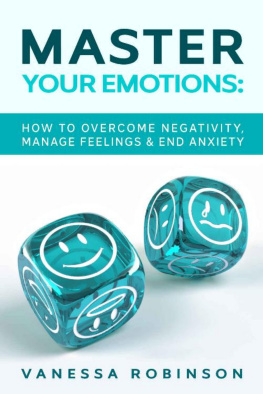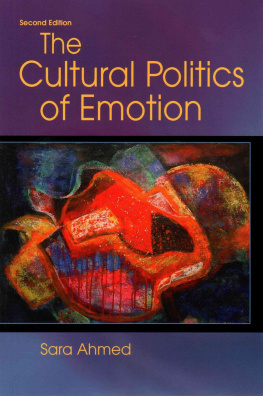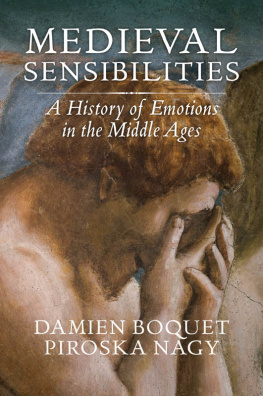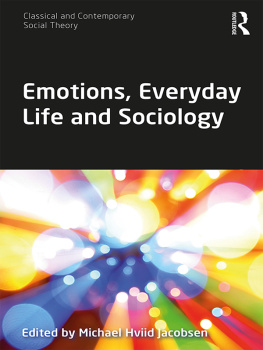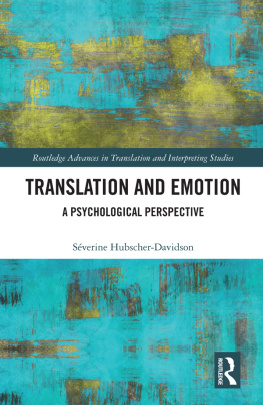
A CULTURAL HISTORY
OF THE EMOTIONS
VOLUME 6
A Cultural History of the Emotions
General Editors: Susan Broomhall, Jane W. Davidson, and Andrew Lynch
Volume 1
A Cultural History of the Emotions in Antiquity
Edited by Douglas Cairns
Volume 2
A Cultural History of the Emotions in the Medieval Age
Edited by Juanita Ruys and Clare Monagle
Volume 3
A Cultural History of the Emotions in the Late Medieval, Reformation, and Renaissance Age
Edited by Andrew Lynch and Susan Broomhall
Volume 4
A Cultural History of the Emotions in the Baroque and Enlightenment Age
Edited by Claire Walker, Katie Barclay, and David Lemmings
Volume 5
A Cultural History of the Emotions in the Age of Romanticism, Revolution, and Empire
Edited by Susan J. Matt
Volume 6
A Cultural History of the Emotions in the Modern and Post-Modern Age
Edited by Jane W. Davidson and Joy Damousi

CONTENTS
INTRODUCTION
CHAPTER 1
CHAPTER 2
CHAPTER 3
CHAPTER 4
CHAPTER 5
CHAPTER 6
CHAPTER 7
CHAPTER 8
The general editors, volume editors and individual authors of this series have many organizations to thank for helping to bring it into existence. They gratefully acknowledge assistance from the Arts and Humanities Research Council (UK); the European Research Council Project, The Social and Cultural Construction of Emotions, University of Oxford, and its Director, Professor Angelos Chaniotis; the Leverhulme Trust; and the Wellcome Trust. Above all, the series has depended on support from the Australian Research Council Centre of Excellence for the History of Emotions (CE110001011). The project was conceived as a key part of the Centres collaborative research work and has benefited greatly from the generous help of its academic and administrative staff.
The general editors also express their deep gratitude to the volume editors and authors for their time, expertise and gracious willingness to revise essays in the light of readers comments. Many other people helped in reading, tracing images and advising in various ways. Our thanks go to Merridee Bailey; Jacquie Bennett; Sophie Boyd-Hurrell; Frederic Kiernan; Mark Neuendorf; Fiona Sim; and Stephanie Thomson; and to the patient staff at Bloomsbury: Dan Hutchins; Claire Lipscomb; Beatriz Lopez; and Rhodri Mogford. We especially acknowledge Ciara Rawnsley, who as Editorial Assistant for the entire series has tirelessly helped authors and done indispensable and meticulous work on all aspects of the volumes preparation.
This series is dedicated to the memory of Philippa Maddern (19522014) who was an original general editor, and an inspiring friend, mentor and colleague to many of the contributors.
JOY DAMOUSI AND JANE W. DAVIDSON
As this volume attests, the twentieth century ushered in distinctive understandings of emotions that transformed how inner life was subsequently understood, especially through the rapidity of change brought about by the massive technological advancements of the period. The automobile transformed itself into a high-speed sports car and a symbol of danger, sex, and money. The airplane made travel over great distances possible and desirable, the allure of holiday destinations creating new ways to experience leisure and pleasure that permitted people of limited financial means to travel at low cost to escape to a new horizon, albeit only for a week or two. In fact, by 1969, it was even possible to visit the Moonthe horizon for excitement and expectation seemed limitless.
In addition to actual transport, the exponential growth in film and TV made journeys to far-flung places or even the deepest recesses of the mind possible through creative imagery. The advent of the computer, then the personal computer and the Internet, coupled with advances in telecommunications, recordings, and radio, meant that the immediacy of experience was shaping how, why, and where emotions were to be expressed: everyday life could be accompanied, monitored, or controlled through these digital and highly accessible means.
During the course of the century, theories of emotion responded to the new technologies and practices, and revolutionized ideas of the place of emotions in all spheres covering medicine and science, philosophy, politics and economics, religion, education, and artistic endeavors. This change is captured particularly in the rise of the history of emotions as a field of academic inquiry, which has provided new scholarly bases for exploring the role and impact of emotions in our lives. Key texts expressing these theoretical developments include Stearns and Stearns (1985), Reddy (2001), Rosenwein (2006), Scheer (2012), and Plamper (2015), although new theoretical developments continue to emerge.
For a series on the cultural history of emotions spanning antiquity to the modern day, volume and chapter divisions are necessary. In this volume, we have followed a remit to examine the period 1920 to the present, beginning with medical and scientific discovery and ending with collectivities and polities, but since the past century has been a time of incredible change in relation to technology and speed of communication, we have decided to focus some of this introductory chapter on the aspects of twentieth-century life and emotions that the main body of the book could not include. Even so, in the few words we have available, we are not comprehensive. Using the world wars and the Cold War period as time-markers, we explore matters ranging from health and well-being to arts and entertainments to reveal the new language for how emotion was framed and experienced.
THE GREAT WAR: EMOTIONS, MOURNING, AND SCIENCE
The First World War created a devastated landscape; the scale of loss and mourning and the cultural practice of it was transformed, leaving desolation in its wake. The public and private expression of grief took place at all levels of society and across class, gender, and ethnicity. Men and women mourned their dead; the living returned from the battlefield broken and wounded. Some never recovered from their injuries; others remained haunted by psychological trauma.
The short- and long-term impacts of the war continue to be assessed a century hence. Much of this evaluation is in terms of the theories that emerged from the cataclysmic event that shaped a generation. Emotions operated at various levels during and immediately after the war. The emotions of the soldiers became a focus of debate and discussion, and those of families and the broader community were writ large across the nations which endured the war. There is no sharper example of the strength of emotion than in the mourning practices and grief that engulfed that generation. Rituals of mourning became central to cultural life. Mourning for the dead became more than a private issue, and the expression of grief took many forms. The scale of death where twice as many men died in the First World War as were killed in all the major wars between 1790 and 1914. Across Europe and beyond, death and grief were palpable (Damousi, 2014). The commemorative movement that emerged aimed to channel the devastation of the war through public events to ritualize emotional expression through public meetings including remembrance services, processions, and concerts.
Next page
